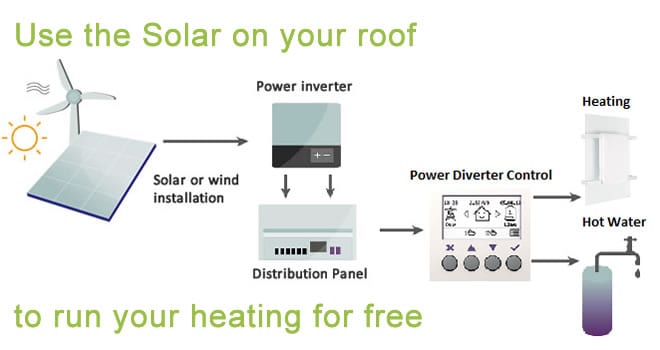
In the near future all heating will be electric, powered by renewable or low carbon sources. Because Infrared heating solutions are modular (i.e. individual panels, no single point of failure in the system) and all solid state (no moving parts to go wrong and require frequent replacement) and significantly less costly to buy and own than Air Source and Ground Source heat pumps, Infrared Heating powered by renewables represents a key strategic opportunity for sustainable low carbon heating. As both Solar and Infrared can be installed by standard electric tradesmen, both systems can be installed by a single qualified contractor.
How do Herschel Infrared and Solar work together?
- Solar electricity is sold to the grid at 4 – 5 pence per unit. If it is used in the home, instead of being sold to the grid, it displaces a unit of electricity having to be bought from the grid at 14-17 pence. So in real terms a unit of electricity generated by home solar saves 3x the value of selling it to the grid.
- This enhances the economics of investing in solar and in providing free heating. This is why Infrared and solar work so well together.
Whilst it could be argued winter months see less sun, the fact is that Solar PV contributes significantly to offset heating costs during the autumn and spring when the heat demand and higher solar output are evenly matched. There are also bright winter days where PV generation is higher.
Using solar to run your heating has real economic value when you consider selling solar to the grid at 4-5 pence/kWh but buying it from the grid for 14-17p/kWh.
Energy Storage
Battery technology is relatively immature still, but offering an increasing means of storing solar-generated electricity for use in the evening and night time.
But remember that Infrared builds energy in the fabric of the building, which in itself acts as an indirect store of energy from the daytime sun.
Control
Monitoring and control both of your heating solution and the solar on your roof is critical in realising the gains of this combination. Both technologies are improving rapidly. In heating terms, the recent LOT20 EcoDesign requirements have dramatically improved savings from heating and with solar PV the onus is on smart usage of the solar power. New diverter technologies like Sharp and SolarEdge intelligently route suplus solar into the home instead of selling it back to the grid. Smappee is another one.
And so
Herschel are at the forefront in the UK of IR / Solar integration with a number of reference projects thanks to their mix of Solar and Radiant heat experts. The combination is an ideal heat and power mix which is simple to design, install and maintain. IR and Solar can use the same electrical contractors in the design and installation which is a considerable advantage over heat pumps which require different contractors to perform just one part of the overall job. It keeps the project planning tight and costs down.
But IR is also a solid state and modular solution (individually connected panels) implying low ongoing maintenance and longevity making for a far lower risk proposition over time than heat pumps, which possess moving parts and compressed gasses and liquids that require costly ongoing maintenance and potential total outage of the whole system when components fail.
